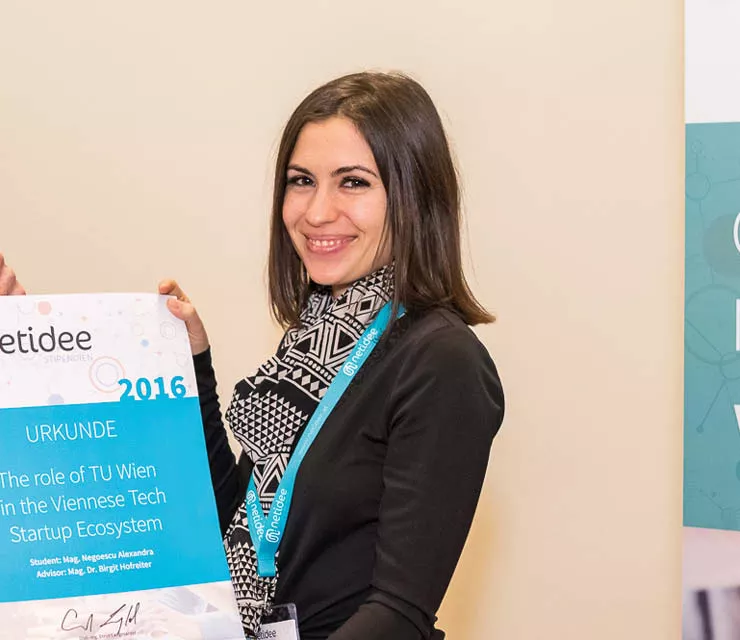
Förderjahr 2016 / Stipendien Call #11 / ProjektID: 1972 / Projekt: The Role of TU Wien in the Viennese Startup Ecosystem
University-business collaboration is a constant discussion and metric for entrepreneurial universities as it has a multi-facet importance:
- Bridging the gap between the contrasting cultural and social aspects of universities and the corporate world
Academia and business have contrasting priorities, each follows their individual rules and have a different approach to research outcome and subsequently contrasting business models. There is an acute need for fostering mutual understanding and finding a common denominator for collaboration without affecting the personal identity of the organizations in question. Striving for a common goal of strategic value for all parties involved will encourage knowledge sharing, support mutual learning and lay the grounds for long-term partnerships and opportunities to drive innovation further.
- Acquiring skills and competencies suitable for the constantly changing labor market
This aspect is not only important for students who are at their first contact with the labor market, but also for re-training and improving existing know-how. The industry is constantly changing due to the emergence of new sectors, each with its specific skillset requirements. With the unemployment rate (9,5% - Jan 2018[1]) significantly higher than the EU average (7,3% - Jan. 2018[2]), Austria can use university-business collaboration as an active tool to lower the unemployment rate.
- Retaining Austrian talent and attracting international talent in the region
The costs for training are significant and the request for up-skilled labor force is in high demand. Today’s skilled workforce is very mobile and prefers working in highly innovative ecosystems, thus emphasizing the idea that innovation is strongly connected with social & cultural mix. With Austria holding the 4th highest rate of graduates at tertiary level (29%) for the STEM field[3] and also of the higher education expenditure in R&D globally[4], it is a significant player in the international mobility of the highly skilled. According to the OECD Science, Technology and Industry Scoreboard 2017[5], the percentage of foreign-born highly skilled individuals is slightly higher than the native-born for Austria. What’s more, when it comes to scientists’ mobility, the same report emphasizes a positive bilateral flow of researchers between Germany and Austria.
- Strong research institutions combined with skilled workforce generate a positive image of the region and is a source of attraction for foreign investments interested in relocating or expanding
In the past decades, Austria has established itself as an innovation center and industrial nation with 50% of the R&D coming from foreign companies[6]
- Low level of private investment in industrial R&D
The low level of private investment in industrial R&D makes joint R&D projects with universities and university-generated research commercialization appealing options for the industry as the main source of access to innovation and new knowledge and technology. This is especially important for small companies which can in this way strengthen and maximize their innovation capacities.
- Changing economic conditions have a lower impact on HEIs
Even in the face of a constantly changing ecosystem centered on the need for cooperation, maintaining its independence and its ability to cater to societal problems needs to be supported by the academia through the appropriate ethical roadmap.
[1] Austria Unemployment Rate | 1960-2018 | Data | Chart | Calendar | Forecast . 2018. Austria Unemployment Rate | 1960-2018 | Data | Chart | Calendar | Forecast . Available at: https://tradingeconomics.com/austria/unemployment-rate. [Accessed 12 March 2018].
[2] Statista. 2018. • Unemployment rate in EU countries 2018 | Statistic. [ONLINE] Available at: https://www.statista.com/statistics/268830/unemployment-rate-in-eu-coun….
[3] OECD (2017), OECD Science, Technology and Industry Scoreboard 2017: The digital transformation, OECD Publishing, Paris. Available at: http://dx.doi.org/10.1787/9789264268821-en
[4] OECD (2017), OECD Science, Technology and Industry Scoreboard 2017: The digital transformation, OECD Publishing, Paris. Available at: http://dx.doi.org/10.1787/9789264268821-en
[5] OECD (2017), OECD Science, Technology and Industry Scoreboard 2017: The digital transformation, OECD Publishing, Paris. Available at: http://dx.doi.org/10.1787/9789264268821-en
[6] Foreign companies account for 50% of R&D expenditure | Invest in Austria. 2018. Foreign companies account for 50% of R&D expenditure | Invest in Austria. Available at: https://investinaustria.at/en/news/2017/10/research-expenditures.php.


